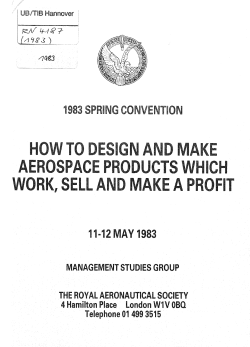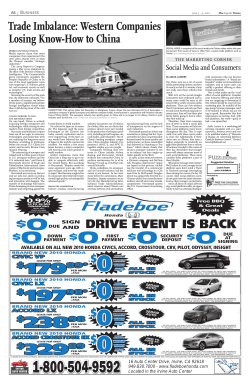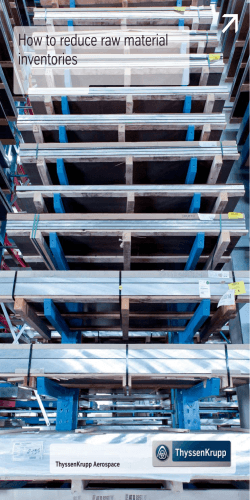
AEROSPACE QUALITY MANAGEMENT SYSTEM STANDARD AS / EN / JIS Q9100
AEROSPACE QUALITY MANAGEMENT SYSTEM STANDARD AS / EN / JIS Q9100 Dale K. Gordon Chairman Americas Aerospace Quality Group SAE Aerospace Committee G-14 Aerospace Quality Standards Numbering System International Standards - 91xx – Are planned for harmonization across all 3 aerospace sectors and are recognized globally Americas Standards - 90xx – Are published for use by AAQG, may become an 91XX standard at a later date “AS” Standards - Americas – Published by Society of Automotive Engineers “EN” Standards - Europe – published in Europe by AECMA “JIS Q” is the Japan / Asia Equivalent 20 February 2001 2 Aerospace Quality System Standards INTERNATIONAL STANDARDS – 9100 - Quality System for Aerospace Manufacturers – 9101 - Checksheet for 9100 – 9110 - Quality System for Aerospace Repair Stations - EAQG – 9111 - Checksheet for 9110 - EAQG only – 9120 - Quality System for Distributors - EAQG – 9121 - Checksheet for 9120 - EAQG 20 February 2001 3 HISTORY - The need to Standardize Aerospace Quality System Requirements Inputs D1-9000 AAQG Process Output AS9000 AAQG formed in 1995 to Standardize Quality Requirements for the Industry 20 February 2001 4 International Quality System Standard Creation 1998 Americas Standard AS9000 European Standard ISO 9001 1994 prEN 9000-1 World Aerospace Quality Standard ; AS/EN/JIS Q 9100 AS9100 ISO TC 20 WG11 EN 9100 20 February 2001 5 Why AS9100? To standardize Aerospace quality expectations on a global level To achieve improvements in quality and reduce costs throughout the value stream ISO 9000 model for quality does not capture regulatory requirements or importance of safety, reliability or maintainability Captures aerospace supplements agreed to at an international level 20 February 2001 6 Aerospace Quality System 9100 Standard versus ISO 9001 9100:1999 added 83 additional and specific requirements to the 20 elements of ISO 9001 – 11 amplifications of ISO 9001 paragraphs are also inserted Emphasis is placed on Design Control, Process Control, Purchasing, Inspection & Testing and Control of Nonconformances – All areas that have the greatest impact on safety and reliability for aerospace products 20 February 2001 7 Aerospace Quality System 9100 versus ISO 9001 Aerospace added Requirements (#) 4.1 Management Resp. (2) 4.2 Quality Systems (7) 4.3 Contract Review (3) 4.4 Design Control (11) 4.5 Document and Data Control (2) 4.6 Purchasing (13) 4.8 Product Identification and Traceability (2) 4.9 Process Control (13) 4.10 Inspection and test. (10) 4.11 Control of Insp., Measure & Test Equipment (3) 4.12 Inspection & Test status (2) 4.13 Control of Nonconforming Product (7) 4.14 Corrective and Preventive Action (2) 4.15 Handling, storage, package, preservation and delivery (1) 4.16 Control of Quality Records (1) 4.17 Internal Quality Audits (2) 4.18 Training (1) 4.20 Statistical Techniques (1) 20 February 2001 8 ISO 9001:2000 QUALITY STANDARD REVISION IMPACT Released in US, EUROPE & JAPAN 1999 • International Writing Team reconvened March 2000 to begin work on ISO 9000:2000 incorporation • Work is almost complete, planned release for standard based on ISO 9000:2000 would be mid 2001 • 9100:1999 & 9100:2001 would co-exist until Nov. 2003 2000 2001 2002 2003 DEC. 2003 ISO 9001:1994 ISO 9001:2000 9100 : 1999 9100 : 2001 20 February 2001 9 ISO 9001:2000 QUALITY STANDARD REVISION IMPACT Aerospace unique requirements are not changed in new version of 9100 – ISO 9000 revision now has requirements desired by industry, eliminating some requirements from 9100:1999 version – Some requirements from ISO 9001:1994 are desired by industry and were added back to 9100:2001 version – 9100:2000 contains 80 aerospace unique requirements and 18 amplifications 20 February 2001 10 9100 Checklist - 9101 IAQG developed 9101 Common Checklist to be used by industry to cover all ISO 9001 & 9100 elements - allows industry to share audit information Must be used by Registrars when performing 9100 audits Optional scoring feature Purchase of 1 copy from SAE will give rights to make unlimited copies for each site that purchases 20 February 2001 11 9110 Repair Station Quality System EN 9110 developed and implemented in Europe for facilities that perform maintenance and repairs of aircraft and aircraft products – Based on 9100 requirements and JAA - JAR 145 requirements • Corresponding 9111 checklist has also been developed and published •International harmonized version for is being worked 20 February 2001 12 9120 Distributor Quality System EN 9120 developed and implemented in Europe for “pass through” distributors that broker or distribute parts and supplies that are used in aerospace products – Checklist 9121 is also available in Europe – Based on 9100, but only applies necessary system requirements. – Americas already has several distributor standards (ASA 100, AS7103) – International harmonized standard is being worked 20 February 2001 13 Industry Leaders are Listening Agreed to improve the overall approach to quality Major Aerospace Companies have agreed upon Quality Management System approval approaches A key objective is to reduce the number of audits There are significant benefits to the Aerospace Industry Working to develop our International processes to incorporate the new approach International approach is based on a single agreed standard, harmonization of system application and shared information Basic structure of the system International Aerospace 3rd Party Accreditation IAQG Scheme issued by SAE/AECMA/SJAC IAQG “oversight” WHAT requirements Americas (equivalent) Americas Scheme oversight Accreditation Body Registrars Auditors Asia (equivalent) Asia Scheme Suppliers Accreditation Body Registrars Auditors Suppliers Accreditation Bodies Registrars Auditors Assessment Suppliers data Data Base Access Usage Aerospace Industry Participants HOW oversight Assessment data Data Base Europe Scheme oversight Assessment Europe data Data Base Process plan for development/implementation Describe the system Get acceptance Communicate the system Implement the system ISSUE DOCUMENTS •document sector schemes •define elements •compare regional schemes •analyse gaps •establish equivalence + harmonisation •amend Sector schemes •document international scheme September 2000 •obtain sector/IAQG acceptance •advise authorities •obtain Accreditation bodies agreement (IAF) •Establish a single IAQG procedure •Final update Sector schemes December 2000 •to Accreditation Bodies •to Registrars/Certification Bodies •to the Regulatory Authorities •to OEM’s & Trade Associations •to suppliers •to the International community 1st Q 2001 •Establish IAQG control mechanism •establish Sector control mechanism •approve ‘a’ registrar and ‘an’ auditor •install register(s) of Registrars and Aerospace auditors •set up data exchange •run the system •monitor and maintain progress 2nd Q 2001 Audits and Approvals Can you imagine a world without audits What a sad place that would be And what would we do with all that spare time IMPROVEMENT We could focus on other things Like product quality and project specific requirements 9100 Implementation Most IAQG Companies are pursuing phased in approach to 9100 most have agreed to put on purchase contract by end of 2001 – Many are targeting specific type of Suppliers for application Some Companies will accept only 2nd Party Approvals – Some will accept 2nd Party Shared Approvals Some Companies will accept 3rd Party Approvals – Some Accept ISO 9001 Certification with 2nd Party audits of 9100 or elements – Some are using 9100 approval as a means for Risk Reduction for 2nd Party Audits FAA has issued Order 8120.12 use of “Other Parties” 20 February 2001 18 Certification / Registration “Other Party” Plans being developed for Certification processes – SBAC procedure TS157 for United Kingdom – SAE AIR5359A for Registrar approval for use by AAQG member companies • AIR5493 - Auditor training requirements – AAQG / EAQG / JAQG to prepare and present procedures for cross evaluation by others (for international use) 2nd Party shared process – AECMA - EASE is being used in EUROPE – Expanded AECMA - EASE being consider for worldwide use 20 February 2001 19 AIR5359A Important Considerations Includes requirements for OEM’s to share audits Includes requirements for auditors – Training requirements are in AIR5493 Includes requirements for reporting results of audits Includes minimum audit times and guidelines Para 9.8 Industry involvement – Must require suppliers to notify OEM’s of status of Registration and any changes thereto – Must report problems with Registrars – Should track suppliers vs. Registrars vs performance 20 February 2001 20 AS9100 Implementation (Americas Companies) 2nd Party - Customer Shared Audits – – – – SAE AIR5359A has sharing plan built-in Customer can ask if Supplier wishes to participate Auditors must meet requirements in AIR 5359A AS9101 Checklist and AIR5359A report must be used and results left with the Supplier – Supplier is then free to offer a copy of results to any other customer – Results may be used in-lieu of an audit or to reduce the amount and intensity of an audit 20 February 2001 21 AS9100 Implementation (Americas Companies) Controlled “Other” Party Plan – AAQG is implementing SAE AIR 5359A document – AIR 5359A is approved & awaiting publication – AAQG is working directly with Accreditation Bodies to approve Registrars and Auditors – 21 Registrars (150 auditors) submitted by RAB have been Accredited to AS9000 – 2 Registrars (and 14 auditors) are Accredited to AS9100 at this time. More are expected soon – Japan is implementing a similar system to AIR 5359A – Europe is planning a variation on the same theme – UK has implemented a compatible scheme 20 February 2001 22 9100 Registration Attributes Salient Points about Registration – OEM’s are not absolving themselves of any responsibilities with respect to the supply chain / products – Registration increases the level of surveillance by covering suppliers that the OEM’s do not cover directly. – Provides for consistent application of requirements throughout the supply chain (9100). – Provides for active industry participation and control. – Provides for data sharing amongst primes and benchmarks the industry in terms of Quality System compliance. – Supplements OEM’s own surveillance process and allows for more focused process and products audits. Single Global Procedure Based on SAE AIR 5359A Embraces all of the key criteria Utilizes generic acronym 9100 It is a 2nd / Other party scheme Includes Registrars and Certification Bodies Sector Management Structure (SMS) Minimum summary data Contains minor sector variants The document has sub-team agreement 20 February 2001 RGM/TS/10073 24 Tomorrow’s world - on our way Single global standards AS/EN9100 Oversight/control by IAQG and Sectors Inter-National Aviation Authority endorsement One audit accepted by all Primes Harmonised systems of application Inter-National Accreditation control International Aerospace Supplier Quality System Evaluation/Certification Active Industry participation Data easily available to all participants Global acceptance by supplier base Approved Cert. Bodies& Registrars Approved Aerospace Auditors Summary A single 9100 Aerospace standard An agreed single International procedure of application Sector scheme procedures harmonised and complete Individual sector launch plans confirmed Implementation planned progressively during 2001 Establish a mechanism for data exchange International auditor training and qualifications Communication to Authorities and Registrars continues No major barriers to implementation Team will co-ordinate implementation programs Monitor and maintain progress COPIES OF STANDARDS, REPORTS AND CHECKLISTS ARE AVAILABLE FROM SAE WWW.SAE.ORG Society of Automotive Engineers 400 Commonwealth Drive Warrendale, PA 15096-0001 QUESTIONS 20 February 2001 28
© Copyright 2025














